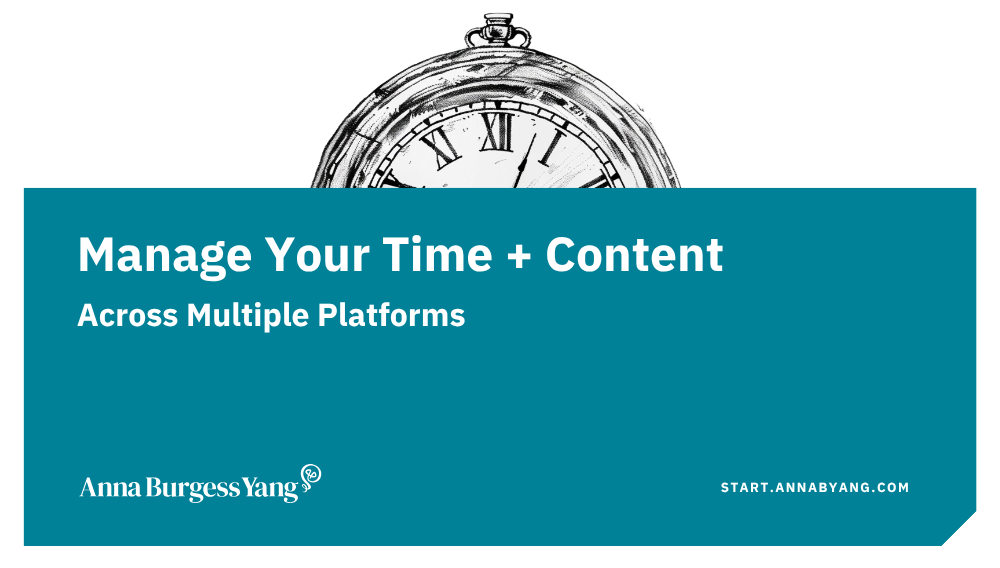How to Maintain an Online Social Presence When You're Going Through Something Rough
Create a plan that makes sense for you.

Marketers love to tell us that “consistency is everything” online. Algorithms reward it, audiences expect it, and your business depends on it. I've given the same advice myself: be consistent.
But here's the truth: sometimes, consistency isn't possible. Life gets in the way. You burn out. Or — in my case — you're diagnosed with a brain tumor.
When you're going through something rough, you shouldn't feel like you have to push through and post nonstop. Instead, you should figure out what type of online social presence honors your current reality.
Re-think your social media strategy
For many years, I've pre-scheduled my social content. A social presence is important for my freelance writing business, so I didn't want to go silent during my recovery time. But I also had to consider what type of content would be low-lift and feasible to prepare in advance.
Give yourself permission to do things differently when you're going through something difficult. You can take a step back and ramp back up when you're ready.
Here are a few ways to approach social media differently while you're dealing with a life event.
Option 1: Lighten your workload without going silent
At the time I found out that I had a brain tumor, I was publishing more than 30 posts per week across my social platforms (LinkedIn, Threads, etc). I expected that I would not be able to work for about 6-8 weeks after brain surgery, and figured that I could pre-schedule enough content during that time.
I quickly realized that it wasn't possible. While I have a large repository of unedited posts that need to be polished, I was also wrapping up client work and dealing with the enormous stress of "I have a brain tumor." I had to rethink my plans and prioritize.
I leaned more heavily into repurposing old content and sharing links to evergreen blog posts. I also promoted some free products I have for freelancers. But I stepped back from the more time-consuming, thoughtful posts I usually write.
Look at your current social media publishing schedule and think about how you can step back without hurting your business. You might want to change the format or publish less frequently.
Option 2: Share authentically (without oversharing)
Depending on your comfort level and the reason you're taking a step back from your business, you may want to share updates.
What I've found — throughout my freelancing career — is that freelancers don't like to talk about the hard stuff. They don't share their challenges (at least not openly, though they might share in private communities).
I wrote very publicly that I had a brain tumor and needed to take a step back from my writing business as I recovered from surgery. My clients were understanding, and by sharing on LinkedIn, I got the word out that I wouldn't be taking on additional work for a period of time. It helped people see the human side of my business.
Several people reached out to me via DM to share their own challenges. I felt that by sharing publicly, I helped people feel less alone, so I continued to share updates as I recovered.
But if you're not comfortable sharing the details of whatever you're going through, you can let people know that you're dealing with something without getting too specific:
"I'm taking things more slowly right now, so you'll see less of me."
"I'm working on some things behind the scenes, but still here!"
"I have some things going on in my personal life that need my attention, so I'm not taking on additional client work right now. But I'll let you know when I return!"
I also shared differently, depending on the social platform. I shared updates every few weeks on LinkedIn, which were interspersed with my regular content. I shared much more openly on Threads, including some posts from my personal blog about my surgery and recovery. The vibes of the two platforms are very different, so I took different approaches.
Option 3: Accept help from people
Because I publicly announced that I had a brain tumor, many people reached out and asked how they could help. And I was ready with a suggestion. I asked people if they would be willing to contribute a guest post to my blog, my newsletter, or my Substack.
I knew that it would be hard to maintain my posting schedule if I had to write dozens of long-form articles in advance. I also had no idea how long it would be before I could write again, so I wanted about two months' worth of posts ready to go.
It was a win-win: I linked to the person's website and/or online profile, so they got additional exposure within my audience. I was able to feature some really interesting voices and perspectives within my publications.
I kept track of everyone who said "yes" in Trello, which is where I plan all of my content. I followed up with people to make sure I got drafts. Then I spent the last week before my surgery pre-scheduling all of the content and pre-writing social posts to share the links for when the posts went live.

Option 4: Use a virtual assistant
Some tasks I could not handle myself while I was recovering from surgery. For example, I share images on Instagram whenever I publish to my Substack or blog. My audience on Instagram is tiny, but I still wanted to maintain my posting schedule.
I relied on my virtual assistant to help me with social posts. Once the content was published on Substack or my blog, she grabbed the images and added them to Instagram posts I'd pre-written.
I also created a process to dictate blog posts. Automation got the transcript of my dictation in front of an editor. She polished it and then sent it to my virtual assistant, who added the post to my website. That way, I could continue writing, even when I couldn't use a computer.
Practical Toolkit
Here are a few of the tools I used to keep my social media presence running while I was recovering from surgery:
- Buffer to pre-schedule my content (my VA also has access)
- Airtable [affiliate link] to store pre-written teasers for yet-to-be-published posts
- Zapier [affiliate link] to automate parts of my content writing process
- Canva templates for low-energy posts
- Trello Project management to keep track of guest posts from other people

Take care of yourself first
Of course, you shouldn't feel pressured to do anything while you're taking a leave from your business.
I spoke to a fellow solopreneur who stepped away from her business for three months when her baby was born. She didn't pre-schedule any content. She dropped a few updates on LinkedIn, "when the spirit moved me" (in her words). And then she picked back up where she'd left off when she was ready.
I considered that for myself, but, frankly, preparing the content was a good distraction in the weeks before I had surgery. If I'd had less time (like an emergency procedure) or been in a different headspace, it would have been a different story.
Consistency matters, but you — as a human — matter more. Social media is an ever-evolving beast, and fully stepping away may have zero impact on your business. In fact, you'll have an opportunity to re-introduce yourself to your audience when you return. You may even find that a major life event changes you in ways that you couldn't predict.
Check out my free guide for creators looking to better manage their time and content across multiple platforms.








